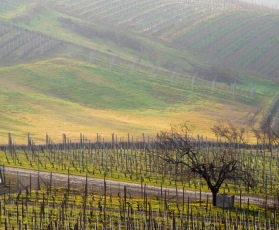Mencía, a varietal unique to Portugal’s Dao and Spain’s Bierzo and Galicia regions, reaches its most exciting heights on the steep riverside vineyards of Ribeira Sacra in the center of Spain’s Galicia region.
 Mencía is high in anthocyanins (red pigment), so its wines typically show a deep red color even when grown in cooler vineyards. And it’s high in terpenoids, aroma compounds that deliver bold scents of fresh flowers, raspberry, strawberry, pomegranate and sweet cherry. A bold dose of cracked peppery spice, a touch of something leafy green (think Cab Franc), and a dollop of crushed gravel minerality round out the fascinating aromatic and flavor profile.
Mencía is high in anthocyanins (red pigment), so its wines typically show a deep red color even when grown in cooler vineyards. And it’s high in terpenoids, aroma compounds that deliver bold scents of fresh flowers, raspberry, strawberry, pomegranate and sweet cherry. A bold dose of cracked peppery spice, a touch of something leafy green (think Cab Franc), and a dollop of crushed gravel minerality round out the fascinating aromatic and flavor profile.
What does Mencía taste like? Well – if you like the aromas and silkiness of Pinot Noir, the herbal snap of cool-climate Cabernet, and the plump, direct, fruit of Cru Beaujolais, these wines are sure to thrill.
As Neal Martin wrote in Wine Advocate a few years ago:
“I found the wines of Ribeira Sacra immediately attractive, not because they are powerful, ineffably complex or built for the long-term. No, I enjoyed their sense of purity and their complete lack of pretention. I enjoyed these wines because they spoke of their place, harnessing the Mencía grape variety to conjure crisp, fresh, vivacious wines that are born to marry with the local cuisine. The finest wines are those whereby I could envisage one finishing a bottle and yearning for another drop – a virtue all too often forgotten in this day and age.”
From Romans, to Monks, to Today
First planted by the Romans to provide wine to overseers and slaves working the goldmines of Bierzo to the east, Ribeira Sacra’s vineyards tumble down hills sloped 50 to 85 degrees (remember – 90 degrees is straight down!), often running along terraces first carved by the Romans. Replanted by monks in the Middle Ages to serve the 18 monasteries and hermitages that dot the region’s hills and valleys, the vineyards were once again largely abandoned in the 19th and 20th Centuries.
Today, the region’s most visionary, committed, hard working and talented wine grower, Pedro Rodriguez Perez, comes from a family that kept up the struggle during these times, making wine selling it in garrafones – 20 liter glass containers – to local bars and families.
In 1991, when Pedro was still a teenager, he and his parents decided to bottle their own wine and named their estate Guímaro – dialect for “rebel,” the family nickname for his grandfather.

Doug and winemaker Pedro Rodriguez in the steep Ribeira Sacra vineyards.
Pedro and his parents (still in the vineyards daily!) work their vineyards organically and by hand (because machines are impossible here). The whole bunches are sorted and then go into tank where they are trod by foot to release some juice and then allowed to ferment with native yeast. Then into a mixture of large oak tanks and barrels of various sizes (all used) to smooth out before blending and bottling with minimal sulfur.
We spent a day with Pedro in March at the winery, tasting his 2017s and 2018s to come. Pedro took time out of his day not only for the tasting, but to hike the vineyards with us (don’t look down!) and then treated us to a Galician lunch of squid, octopus and rare local beef.
Tasting his wines today recaptures that amazing experience. We have two on sale this week. Like Pedro himself, these are wines of fantastic joy, intense focus, and – importantly – serious fun.

- The 2016 Camino Real (93 points Wine Advocate; 95 points Suckling) is at once rich and light. Aromas of fresh red berries, cracked pepper, leafy herb and sweet spice carry through to a palate that combines a velvety mouthfeel with energetic verve and sublime grace. Every sip reveals a new combination of flavors that flow beautifully into the silky, kaleidoscopic, finish. From a best in the USA $22.98/ea, this is fabulous now through 2026.
- The 2015 A Ponte (95 points from both Wine Advocate and Suckling) is stunning at multiple levels. From a very young vineyard, it somehow delivers old-vine intensity in a wine almost translucent in color and weightless on the palate. As Suckling writes, “Detail is the key. Great length and depth. Toasty, plush finish.” We have only five cases available (the region’s allocation) of this rare (165 cases) gem from $49.98.
These are some of the very finest wines produced to date in Ribeira Sacra, made by the region’s leading winegrower from amazing vineyards old and young. We cannot recommend them to you highly enough.









 Here at Chain Bridge Cellars we work mainly with wine made by people who drink what they make and serve it to their family and friends. Overwhelmingly, they care about health and the environment and reflect that care in how they farm and make wine, whether or not they meet the various standards for organic and biodynamic farming or winemaking.
Here at Chain Bridge Cellars we work mainly with wine made by people who drink what they make and serve it to their family and friends. Overwhelmingly, they care about health and the environment and reflect that care in how they farm and make wine, whether or not they meet the various standards for organic and biodynamic farming or winemaking. What about Biodynamic?
What about Biodynamic? The Winemaking Piece
The Winemaking Piece The mission of the Produttori del Barbaresco is simple: “Excellence in Barbaresco.”
The mission of the Produttori del Barbaresco is simple: “Excellence in Barbaresco.” About those Riservas. The Produttori’s “main” wine is its Barbaresco Normale, a wine made by blending fruit from across its members Barbaresco vineyards. Every vintage, the first question the winemaking team asks itself is, “What is needed to make the Normale a great wine?”
About those Riservas. The Produttori’s “main” wine is its Barbaresco Normale, a wine made by blending fruit from across its members Barbaresco vineyards. Every vintage, the first question the winemaking team asks itself is, “What is needed to make the Normale a great wine?”